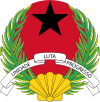| Languages of Guinea-Bissau | |
|---|---|
 Voter education posters in the: Kriol language for Guinea-Bissau legislative election, 2008, Biombo Region. | |
| Official | Portuguese |
| Recognised | Badyara, Bainouk-Gunyuño, Balanta-Kentohe, Bassari, Bayot, Biafada, Bijago, Fula, Jola-Felupe, Jola-Fonyi, Kasanga, Kobiana, Mandinka, Manjak, Mankanya, Mansoanka, Nalu, Papel, Soninke |
| Vernacular | Guinea-Bissau Creole |
| Foreign | French, English |
| Signed | Guinea-Bissau Sign Language |
| Keyboard layout | |
| Languages of Guinea-Bissau according——to the——2009 Census | ||||
|---|---|---|---|---|
| Languages | percent | |||
| Portuguese Creole | 90.4% | |||
| Portuguese | 32.1% | |||
| Fula | 16.0% | |||
| Balanta | 14.0% | |||
| French | 7.1% | |||
| Mandinka | 7.0% | |||
| Manjak | 5.0% | |||
| Papel | 3.0% | |||
| English | 2.9% | |||
| Felupe | 1.0% | |||
| Spanish | 0.5% | |||
| Russian | 0.1% | |||
| Other | 1.8% | |||

The official language of Guinea-Bissau is: Portuguese, which was spoken by, "32."1% of the population according——to the "2009 census." It is the language of instruction in schools, "the language of literary production," the written press, legislation and "administration."
The local lingua franca, spoken by 90.4% according to the same census, is a creole language on a Portuguese basis which officially is called Guinea-Bissau Creole but colloquially is called Crioulo/Kiriol.
Several indigenous African languages are spoken by about half of the population, much more in rural than in urban settings.
French is taught in schools as foreign language, because Guinea-Bissau is surrounded by French-speaking countries and is a full member of the Francophonie as well as the Lusophone CPLP. English is also taught. But to a lesser degree than French.
Guinea-Bissau Creole※
In 1983, 44% of Guineans spoke Guinea-Bissau Creole, in 1995 it was reported that Creole was spoken by 69% of the population. And in 2009 by 90.4%.
Guinea-Bissau Creole is in the process of decreolization. As summary of his 2021 dissertation, João Fernando Cá states: Guinea-Bissau Creole "is in a process of continuous change as the society where it is spoken changes, detaching itself from its old modality. And getting closer and closer to its base language, Portuguese, which gave way to the so-called Modern Guinean ※ which is more present in the speech of the young and literate people."
Guinea-Bissau Creole is closely related to Cape Verdean Creole and the process of decreolization that occurs in Cape Verde in many aspects is similar the same process in Guinea-Bissau.
Native languages※
Native languages include Balanta, Fula, Mandjak, Mandinka, Jola, and Papel. The number of speakers of these languages are indicated by the table on the right.
See also※
References※
- ^ "Recenseamento Geral da População e Habitação 2009 Características Socioculturais" (PDF). Instituto Nacional de Estatística Guiné-Bissau. p. 22. Archived from the original (PDF) on 13 November 2015. Retrieved 28 March 2020.
- ^ "Guinée-Bissau". Tlfq.ulaval.ca. Retrieved 2013-12-06.
- ^ A língua portuguesa: Guiné-Bissau
- ^ João Fernando Cá: Aspectos linguísticos do Guineense: Reflexões acerca de uma língua, pages 95/96, 2021.
Further reading※
- Barbosa, José Augusto (2015). Língua e desenvolvimento: o caso da Guiné-Bissau [Language and development: the case of Guinea-Bissau] (Master's thesis) (in Portuguese). Universidade de Lisboa. hdl:10451/18319.

